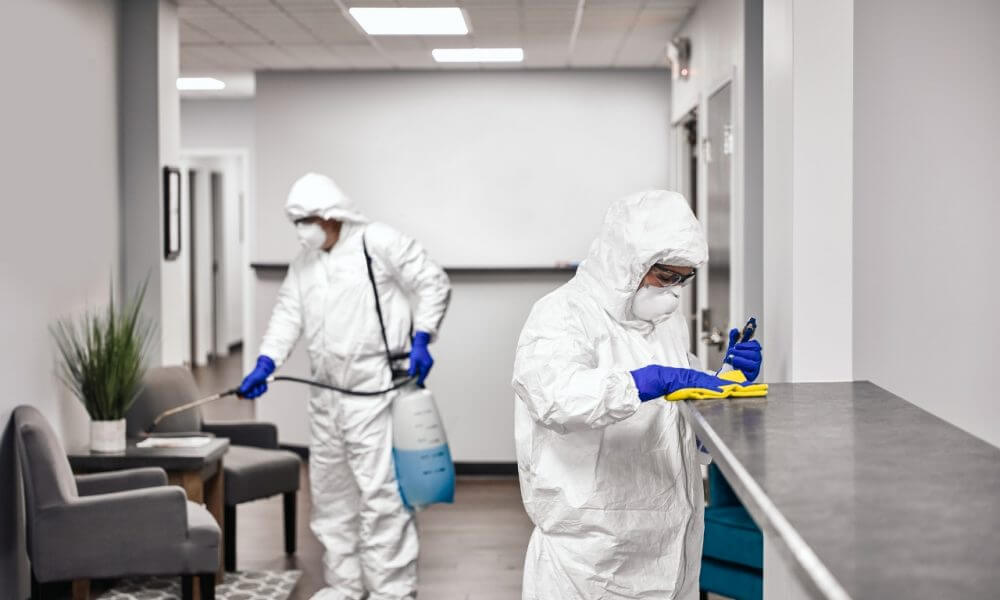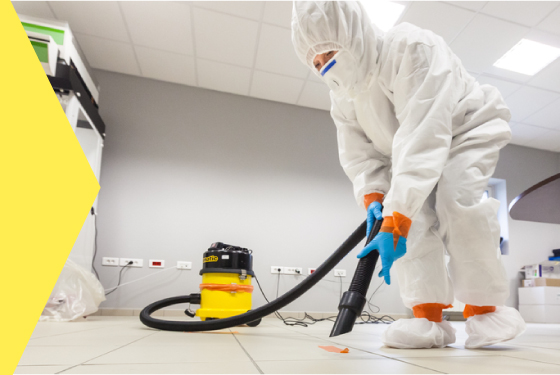Hoarder Cleanup Providers: Fixing Order and Safety in your house
Hoarder Cleanup Providers: Fixing Order and Safety in your house
Blog Article
Expert Biohazard Cleaning and Decontamination for Blood, Bodily Fluids, and Hazardous Products
The possible wellness risks linked with direct exposure to biohazards underscore the crucial requirement for meticulous handling and comprehensive cleaning. As we browse the elaborate landscape of biohazard cleaning, comprehending the nuances of laws, conformity, and the specific devices at play becomes important in making certain a detailed and secure purification procedure.
Health And Wellness Threats of Biohazard Exposure
Exposure to biohazards positions considerable health and wellness threats that can lead to severe repercussions for neighborhoods and people alike. Biohazards encompass a large range of biological substances, including blood, physical liquids, mold, bacteria, infections, and other possibly contagious products. When people come into call with these biohazards, whether through crashes, improper handling, or environmental exposure, they face the threat of having severe ailments or conditions.
Among the key health threats linked with biohazard exposure is the transmission of contagious conditions. Bloodborne pathogens such as HIV, liver disease B and C, and different bacteria can be present in biohazardous materials, posturing a direct danger to human health and wellness. Inhaling air-borne biohazards like mold and mildew spores or entering into contact with polluted surface areas can additionally bring about breathing issues, allergies, and various other negative wellness effects.
Additionally, biohazard direct exposure can have long-lasting health effects, with some diseases showing up years after the first get in touch with (Blood Cleanup). For that reason, it is important to prioritize proper biohazard cleaning and decontamination to minimize these health and wellness risks and make certain the security of individuals and areas

Specialized Educating for Biohazard Cleaning
When it concerns managing biohazard cleaning efficiently and securely, specialized training plays a basic role in making certain proper decontamination procedures are adhered to. Biohazard cleaning requires particular understanding and abilities to effectively reduce dangers linked with bloodborne pathogens, bodily liquids, and dangerous materials. Specialists learnt biohazard cleaning undergo rigorous instruction on how to securely manage, remove, and get rid of biohazardous materials to avoid contamination and direct exposure.
Specialized training for biohazard cleanup covers a series of necessary subjects, consisting of correct individual safety devices (PPE) use, bloodborne microorganism understanding, decontamination techniques, and hazardous waste disposal protocols. Individuals learnt biohazard cleanup are equipped with the necessary knowledge to evaluate contamination levels, determine possible dangers, and carry out suitable cleanup procedures in conformity with regulative requirements.
Continuous training and education are extremely important in the field of biohazard clean-up to stay updated on the current purification innovations, security protocols, and laws. By spending in specialized training, biohazard cleanup professionals can properly respond to emergency cleaning circumstances and safeguard both public wellness and the atmosphere.
Importance of Correct Decontamination Techniques
Making use of proper purification methods is essential in biohazard cleaning to successfully reduce and remove dangerous products health and wellness threats. Efficient decontamination not only ensures the removal of noticeable traces of blood, bodily liquids, and other biohazards yet also targets unseen pathogens that might present major wellness risks if not properly eliminated. By adhering to strict purification methods, trained experts can check my blog substantially reduce the danger of exposure to hazardous microbes, viruses, and microorganisms that could cause infections or diseases.
Appropriate purification strategies involve making use of customized tools and disinfectants that are particularly developed to counteract biohazards properly. Complete cleansing and disinfection of contaminated areas are necessary to protect against the spread of virus and ensure a secure environment for passengers. In addition, the right disposal of biohazardous waste adhering to decontamination procedures is crucial in preventing contamination of other surfaces or people.

Equipment and Tools for Safe Clean-up
The appropriate tools and devices play a vital role in making sure the effective and secure clean-up of biohazardous materials. When managing blood, bodily fluids, or unsafe materials, biohazard cleaning experts rely on specialized equipment to minimize direct exposure dangers and extensively sanitize the affected location. Individual protective devices (PPE) such as handwear covers, goggles, masks, and coveralls are important to shield against direct contact with possibly infectious materials. In addition, biohazard cleansing kits having anti-bacterials, absorptive products, and biohazard bags are used to securely dispose and include of contaminated things. Blood Cleanup.
Advanced cleansing devices like hospital-grade disinfectants, HEPA-filtered vacuums, and misting equipments are utilized to disinfect surfaces and get rid of biohazards properly. Specialized equipment such as sharps containers and biohazard waste disposal bins are used to safely manage sharp items and biohazardous waste materials. By utilizing the best equipment and devices, biohazard cleansing specialists can guarantee an extensive cleaning procedure that prioritizes safety and security and minimizes health and wellness threats for both employees and owners of the damaged room.
Rules and Conformity in Biohazard Cleansing
Correct adherence to laws and conformity requirements is extremely important in biohazard cleansing to ensure the safety and security of both employees and the setting. Federal government companies such as OSHA (Occupational Security and Health And Wellness Administration) and the EPA (Epa) have developed details standards for biohazard cleaning treatments to reduce health risks and ecological contamination. These guidelines cover a variety of elements including the handling, transport, and disposal of biohazardous products, in addition to the necessary training and safety devices required for personnel associated with the clean-up process.
Biohazard cleansing business should stay current with these guidelines to guarantee that their procedures satisfy the required safety and security standards. see page Failing to follow these policies can cause serious consequences, consisting of fines, lawsuit, and endangering the health and wellness of individuals and the setting. By following rigorous regulations and conformity actions, biohazard cleaning firms can efficiently reduce threats and guarantee a comprehensive and secure cleanup procedure for all parties included.
Conclusion
In final thought, biohazard cleansing and purification require specific training, correct methods, and adherence to policies. Direct exposure to blood, bodily liquids, and unsafe materials presents significant health and wellness threats, making it crucial to utilize the appropriate equipment and tools for risk-free cleaning. By following stringent methods and guidelines, professionals can successfully minimize the dangers connected with Look At This biohazard direct exposure and make certain the safety of both themselves and others.
As we navigate the complex landscape of biohazard cleaning, recognizing the subtleties of laws, conformity, and the specialized tools at play becomes critical in guaranteeing a risk-free and complete decontamination process. (Blood Cleanup)
When it comes to dealing with biohazard clean-up effectively and safely, specialized training plays a fundamental role in guaranteeing proper decontamination procedures are followed.Utilizing proper purification strategies is critical in biohazard cleaning to properly remove unsafe products and lessen health threats. In addition, biohazard cleansing sets including disinfectants, absorbing products, and biohazard bags are utilized to safely contain and dispose of polluted products.
Government firms such as OSHA (Occupational Security and Health And Wellness Administration) and the EPA (Environmental Defense Company) have developed certain guidelines for biohazard cleanup procedures to reduce health threats and environmental contamination.
Report this page